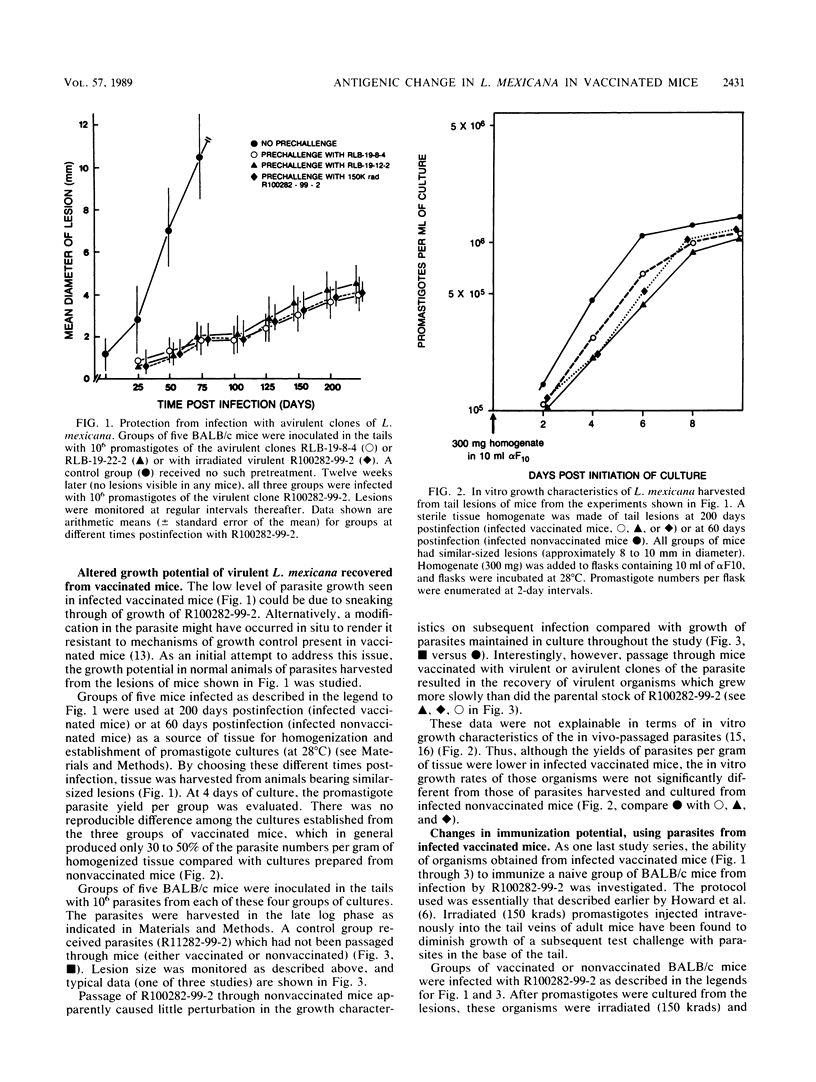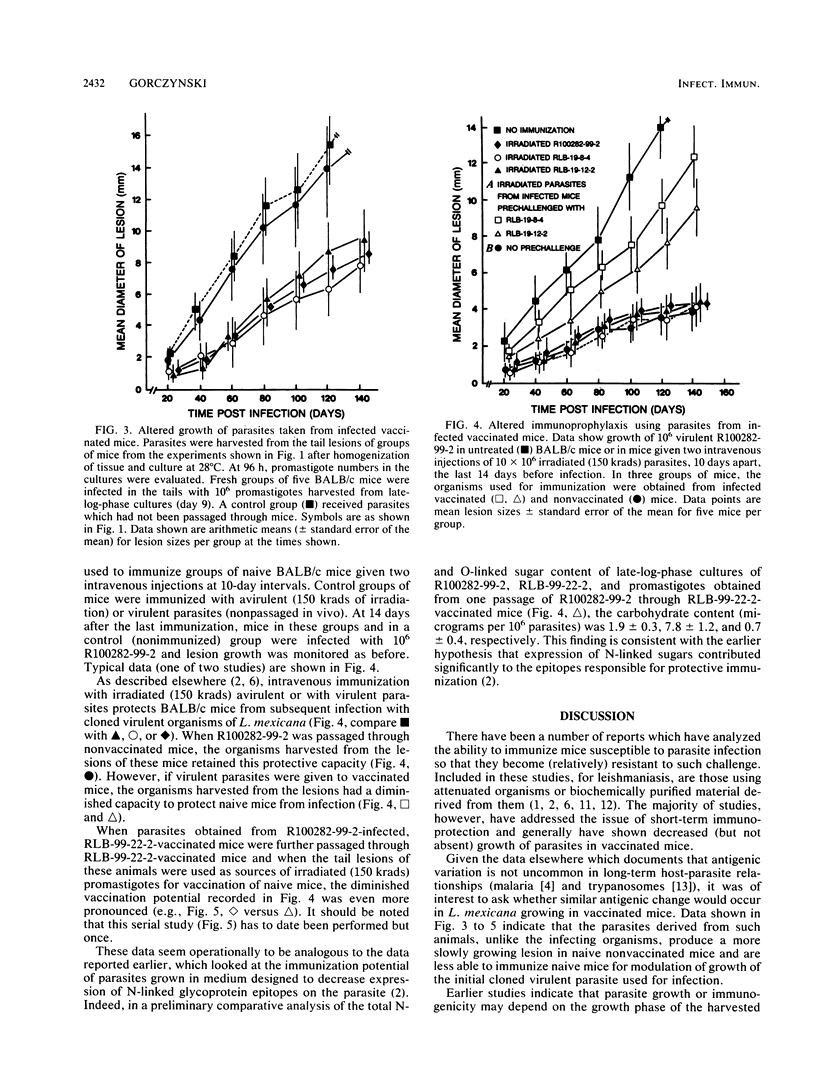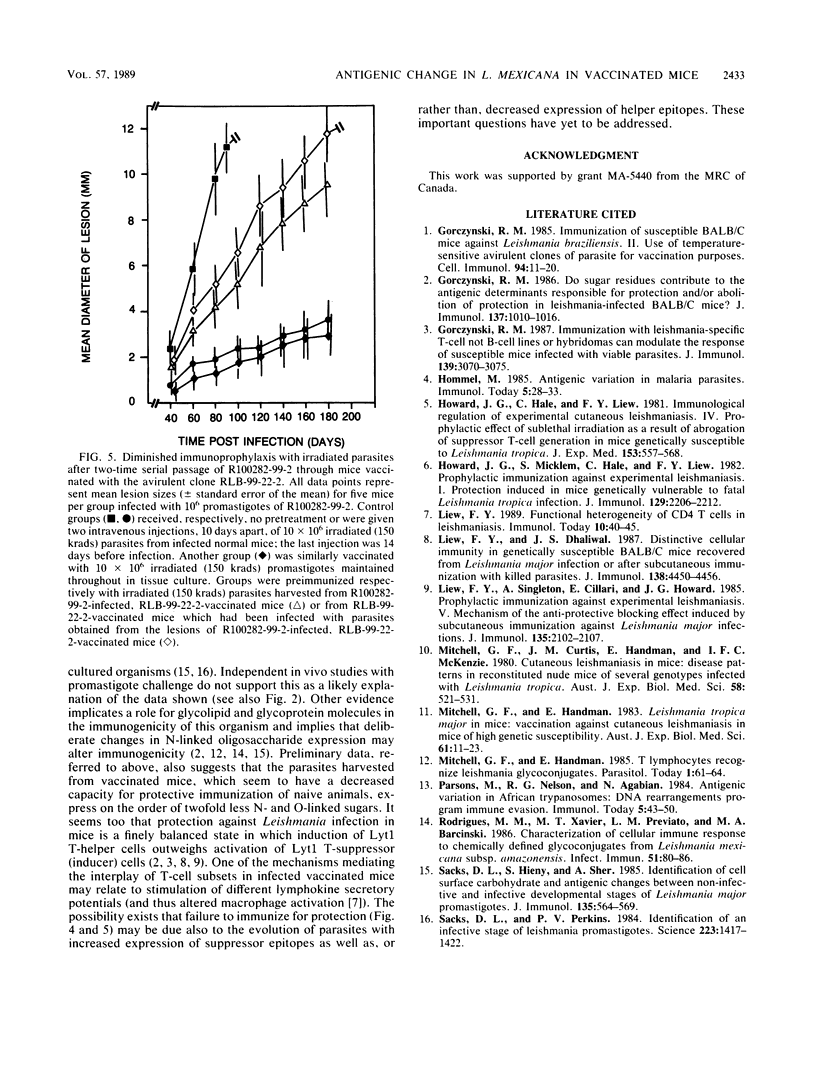Abstract
BALB/c mice, which are normally highly susceptible to growth of Leishmania mexicana parasites in vivo, can be vaccinated with avirulent temperature-sensitive mutants of L. mexicana so that challenge with virulent organisms results in markedly diminished growth of the latter. Parasites extracted from the lesions which do appear in these mice are able to produce active infection in secondary hosts, although the rate of progression of these lesions is slower than that seen with the original virulent cloned organism. Interestingly, when irradiated parasites from the secondary hosts are themselves used to vaccinate naive BALB/c mice, less protection is seen than when irradiated virulent organisms from the initial infecting clone are used. These data suggest that when infection does take place in mice vaccinated with avirulent clones of parasite, the organisms which develop in lesions in these animals are substantially modified from those present in the initial infecting inoculum.
Full text
PDF



Selected References
These references are in PubMed. This may not be the complete list of references from this article.
- Gorczynski R. M. Do sugar residues contribute to the antigenic determinants responsible for protection and/or abolition of protection in Leishmania-infected BALB/c mice? J Immunol. 1986 Aug 1;137(3):1010–1016. [PubMed] [Google Scholar]
- Gorczynski R. M. Immunization of susceptible BALB/c mice against Leishmania braziliensis. II. Use of temperature-sensitive avirulent clones of parasite for vaccination purposes. Cell Immunol. 1985 Aug;94(1):11–20. doi: 10.1016/0008-8749(85)90081-4. [DOI] [PubMed] [Google Scholar]
- Gorczynski R. M. Immunization with Leishmania-specific T cell not B cell lines or hybridomas can modulate the response of susceptible mice infected with viable parasites. J Immunol. 1987 Nov 1;139(9):3070–3075. [PubMed] [Google Scholar]
- Howard J. G., Hale C., Liew F. Y. Immunological regulation of experimental cutaneous leishmaniasis. IV. Prophylactic effect of sublethal irradiation as a result of abrogation of suppressor T cell generation in mice genetically susceptible to Leishmania tropica. J Exp Med. 1981 Mar 1;153(3):557–568. doi: 10.1084/jem.153.3.557. [DOI] [PMC free article] [PubMed] [Google Scholar]
- Howard J. G., Nicklin S., Hale C., Liew F. Y. Prophylactic immunization against experimental leishmaniasis: I. Protection induced in mice genetically vulnerable to fatal Leishmania tropica infection. J Immunol. 1982 Nov;129(5):2206–2212. [PubMed] [Google Scholar]
- Liew F. Y., Dhaliwal J. S. Distinctive cellular immunity in genetically susceptible BALB/c mice recovered from Leishmania major infection or after subcutaneous immunization with killed parasites. J Immunol. 1987 Jun 15;138(12):4450–4456. [PubMed] [Google Scholar]
- Liew F. Y. Functional heterogeneity of CD4+ T cells in leishmaniasis. Immunol Today. 1989 Feb;10(2):40–45. doi: 10.1016/0167-5699(89)90302-2. [DOI] [PubMed] [Google Scholar]
- Liew F. Y., Singleton A., Cillari E., Howard J. G. Prophylactic immunization against experimental leishmaniasis. V. Mechanism of the anti-protective blocking effect induced by subcutaneous immunization against Leishmania major infection. J Immunol. 1985 Sep;135(3):2102–2107. [PubMed] [Google Scholar]
- Mitchell G. F., Curtis J. M., Handman E., McKenzie I. F. Cutaneous leishmaniasis in mice: disease patterns in reconstituted nude mice of several genotypes infected with Leishmania tropica. Aust J Exp Biol Med Sci. 1980 Oct;58(5):521–532. doi: 10.1038/icb.1980.54. [DOI] [PubMed] [Google Scholar]
- Mitchell G. F., Handman E. Leishmania tropica major in mice: vaccination against cutaneous leishmaniasis in mice of high genetic susceptibility. Aust J Exp Biol Med Sci. 1983 Feb;61(Pt 1):11–25. doi: 10.1038/icb.1983.2. [DOI] [PubMed] [Google Scholar]
- Mitchell G. F., Handman E. T-lymphocytes recognise Leishmania glycoconjugates. Parasitol Today. 1985 Aug;1(2):61–63. doi: 10.1016/0169-4758(85)90117-6. [DOI] [PubMed] [Google Scholar]
- Rodrigues M. M., Xavier M. T., Previato L. M., Barcinski M. A. Characterization of cellular immune response to chemically defined glycoconjugates from Leishmania mexicana subsp. amazonensis. Infect Immun. 1986 Jan;51(1):80–86. doi: 10.1128/iai.51.1.80-86.1986. [DOI] [PMC free article] [PubMed] [Google Scholar]
- Sacks D. L., Hieny S., Sher A. Identification of cell surface carbohydrate and antigenic changes between noninfective and infective developmental stages of Leishmania major promastigotes. J Immunol. 1985 Jul;135(1):564–569. [PubMed] [Google Scholar]
- Sacks D. L., Perkins P. V. Identification of an infective stage of Leishmania promastigotes. Science. 1984 Mar 30;223(4643):1417–1419. doi: 10.1126/science.6701528. [DOI] [PubMed] [Google Scholar]


